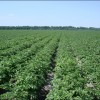 This 6-page fact sheet provides information on the importance of nitrogen budgets for potato cultivation and discusses the steps in preparing the budget. It allows growers to understand the inputs, cycling, and exports of nutrients within and away from the farm, develop a nutrient budget, and analyze best management practices (BMPs) for their farm. The results will be increased N fertilizer use efficiency, increased environmental protection, and reduced economic losses associated with potato cultivation. This document will also aid county agents, environmental management advisors, and government agency staff members who help farmers improve and implement nutrient BMPs to protect water quality. Written by Rishi Prasad and George Hochmuth, and published by the UF Department of Soil and Water Science, December 2013.
This 6-page fact sheet provides information on the importance of nitrogen budgets for potato cultivation and discusses the steps in preparing the budget. It allows growers to understand the inputs, cycling, and exports of nutrients within and away from the farm, develop a nutrient budget, and analyze best management practices (BMPs) for their farm. The results will be increased N fertilizer use efficiency, increased environmental protection, and reduced economic losses associated with potato cultivation. This document will also aid county agents, environmental management advisors, and government agency staff members who help farmers improve and implement nutrient BMPs to protect water quality. Written by Rishi Prasad and George Hochmuth, and published by the UF Department of Soil and Water Science, December 2013.
http://edis.ifas.ufl.edu/ss614
Category: Crops
Methods for Measuring Controlled-Release Fertilizer Nitrogen Release Used for Vegetable Production
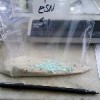 Enhanced-efficiency fertilizers are a group of fertilizers that reduce the risk of nutrient loss to the environment and subsequently increase fertilizer use efficiency. This increase may be accomplished through maintaining nutrients in the root zone by physical barriers, reduced solubility, or retaining nutrients in a less leachable form. This 7-page fact sheet examines laboratory, growth chamber, greenhouse, and field methods for measuring nitrogen release in controlled-release fertilizers. Written by Monica Ozores-Hampton and Luther C. Carson, and published by the UF Department of Horticultural Sciences, August 2013.
Enhanced-efficiency fertilizers are a group of fertilizers that reduce the risk of nutrient loss to the environment and subsequently increase fertilizer use efficiency. This increase may be accomplished through maintaining nutrients in the root zone by physical barriers, reduced solubility, or retaining nutrients in a less leachable form. This 7-page fact sheet examines laboratory, growth chamber, greenhouse, and field methods for measuring nitrogen release in controlled-release fertilizers. Written by Monica Ozores-Hampton and Luther C. Carson, and published by the UF Department of Horticultural Sciences, August 2013.
http://edis.ifas.ufl.edu/hs1227
Corn wireworm Melanotus communis Gyllenhal (Insecta: Coleoptera: Elateridae)
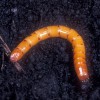 Insects in the family Elateridae are commonly known as click beetles. Their name comes from the clicking sound they make while attempting to right themselves after falling or being placed on their backs. The larvae of click beetles are called wireworms. The corn wireworm is a serious agricultural pest and was added to the EPPO A1 action list of quarantine pests in 2002. This 6-page fact sheet was written by Harsimran K. Gill, Gurminder Chahil, Gaurav Goyal, Jennifer L. Gillett-Kaufman and Ronald Cherry, and published by the UF Department of Entomology and Nematology, January 2014.
Insects in the family Elateridae are commonly known as click beetles. Their name comes from the clicking sound they make while attempting to right themselves after falling or being placed on their backs. The larvae of click beetles are called wireworms. The corn wireworm is a serious agricultural pest and was added to the EPPO A1 action list of quarantine pests in 2002. This 6-page fact sheet was written by Harsimran K. Gill, Gurminder Chahil, Gaurav Goyal, Jennifer L. Gillett-Kaufman and Ronald Cherry, and published by the UF Department of Entomology and Nematology, January 2014.
http://edis.ifas.ufl.edu/in1025
2013 Evaluation of Non-Irrigated Mid- to Full-Season Maturing Cotton Varieties in Jay, Florida
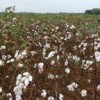 This report includes a summary of the 2013 mid- to full-season cotton Official Variety Trial in Jay, Florida. It shows the performance of 16 cotton varieties. This data represents only one year and one location, and readers are cautioned that test results should be considered over several locations and years before final conclusions are valid. This 5-page fact sheet was written by Darcy E. P. Telenko and Michael Donahoe, and published by the UF Department of Agronomy, January 2014.
This report includes a summary of the 2013 mid- to full-season cotton Official Variety Trial in Jay, Florida. It shows the performance of 16 cotton varieties. This data represents only one year and one location, and readers are cautioned that test results should be considered over several locations and years before final conclusions are valid. This 5-page fact sheet was written by Darcy E. P. Telenko and Michael Donahoe, and published by the UF Department of Agronomy, January 2014.
http://edis.ifas.ufl.edu/ag377
Healing Chamber for Grafted Vegetable Seedlings in Florida
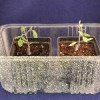 Grafting is a horticultural technology that combines two plants, the scion and the rootsock, to create a plant with desirable features from both parts. In the United States the use of vegetable grafting in field production remains limited, although 70% of the total hydroponic greenhouse tomato area uses grafted seedlings. Large, commercial grafting operations use controlled-environment growth chambers, but the high cost limits their use in most small-scale grafting operations. Healing chambers are an alternative solution that provides proper healing at a lower cost for growers and researchers. This 5-page fact sheet was written by Monica Ozores-Hampton and Aline Coelho Frasca, and published by the UF Department of Horticultural Sciences, October 2013.
Grafting is a horticultural technology that combines two plants, the scion and the rootsock, to create a plant with desirable features from both parts. In the United States the use of vegetable grafting in field production remains limited, although 70% of the total hydroponic greenhouse tomato area uses grafted seedlings. Large, commercial grafting operations use controlled-environment growth chambers, but the high cost limits their use in most small-scale grafting operations. Healing chambers are an alternative solution that provides proper healing at a lower cost for growers and researchers. This 5-page fact sheet was written by Monica Ozores-Hampton and Aline Coelho Frasca, and published by the UF Department of Horticultural Sciences, October 2013.
http://edis.ifas.ufl.edu/hs1232
Veggies and Herbs: Made in the Shade A Growing Season Calendar for North Florida
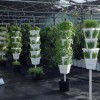 The importance of using an open shade structure for hydroponic crop culture in Florida has recently increased. Prior to the turn of the century, hydroponic culture in Florida was done inside a greenhouse structure, but it has now expanded to several other types of structures. In addition to greenhouses, production now exists in high tunnels, insect screens or net houses, and open shade-covered structures. In southern parts of Florida, outdoor hydroponic systems without any structure are becoming more common. In those cases, many operations use a polypropylene cover for freeze protection. Diversifying structures stems from growers’ desires to extend the season to meet consumer demand for a longer time period. The purpose of this publication is to indicate what crops have been successfully grown under shade in northern Florida at various times of the year. This 4-page fact sheet was written by Daniel K. Fenneman, Robert C. Hochmuth, Wanda L. Laughlin, and Sean R. McCoy, and published by the UF Department of Horticultural Sciences, November 2014.
The importance of using an open shade structure for hydroponic crop culture in Florida has recently increased. Prior to the turn of the century, hydroponic culture in Florida was done inside a greenhouse structure, but it has now expanded to several other types of structures. In addition to greenhouses, production now exists in high tunnels, insect screens or net houses, and open shade-covered structures. In southern parts of Florida, outdoor hydroponic systems without any structure are becoming more common. In those cases, many operations use a polypropylene cover for freeze protection. Diversifying structures stems from growers’ desires to extend the season to meet consumer demand for a longer time period. The purpose of this publication is to indicate what crops have been successfully grown under shade in northern Florida at various times of the year. This 4-page fact sheet was written by Daniel K. Fenneman, Robert C. Hochmuth, Wanda L. Laughlin, and Sean R. McCoy, and published by the UF Department of Horticultural Sciences, November 2014.
http://edis.ifas.ufl.edu/hs1228
Compact Growth Habit Tomatoes
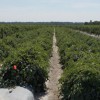 Alternatives to the traditional production system that reduce production cost would be economically beneficial to the Florida tomato industry. Compact growth habit tomatoes are determinate varieties with a unique architecture that may provide the basis for a viable alternative production system for Florida. These tomatoes have low growth and spreading characteristics, forming compact plants that hold fruit above the ground on short branches. They do not require staking, tying, or pruning, so they may be used by the Florida mature-green fresh-market tomato growers to reduce labor costs. This 5-page fact sheet was written by Monica Ozores-Hampton, Aline Coelho Frasca, John Scott, and Samuel Hutton, and published by the UF Department of Horticultural Sciences, September 2014.
Alternatives to the traditional production system that reduce production cost would be economically beneficial to the Florida tomato industry. Compact growth habit tomatoes are determinate varieties with a unique architecture that may provide the basis for a viable alternative production system for Florida. These tomatoes have low growth and spreading characteristics, forming compact plants that hold fruit above the ground on short branches. They do not require staking, tying, or pruning, so they may be used by the Florida mature-green fresh-market tomato growers to reduce labor costs. This 5-page fact sheet was written by Monica Ozores-Hampton, Aline Coelho Frasca, John Scott, and Samuel Hutton, and published by the UF Department of Horticultural Sciences, September 2014.
http://edis.ifas.ufl.edu/hs1231
Late Blight of Tomato and Potato
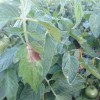 Late blight is showing up on tomatoes and potatoes around southwest Florida. This is an aggressive disease capable of rapidly destroying entire fields. The disease is distributed worldwide and occurs wherever tomatoes or potatoes are grown and conditions favor disease development.
Late blight is showing up on tomatoes and potatoes around southwest Florida. This is an aggressive disease capable of rapidly destroying entire fields. The disease is distributed worldwide and occurs wherever tomatoes or potatoes are grown and conditions favor disease development.
http://edis.ifas.ufl.edu/pp301
Stink Bugs in Florida Rice
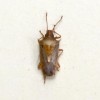 Although many different insects can be found in rice fields in Florida, stink bugs are currently considered the most important pest. Jones and Cherry reported that the rice stink bug was the dominant species, comprising more than 95% of the total stink bug population. Cherry et al. (1998) reported that the stink bug Oebalus ypsilongriseus was widespread in Florida rice fields. This was the first report of this species being found in commercial rice fields in the United States. Cherry and Nuessly (2010) reported that the stink bug Oebalus insularis is now widespread in Florida rice fields. This was the first report of this species being found in commercial rice fields in the United States. The stink bug complex attacking Florida rice is the most diversified and unique stink bug complex in US rice production. This 4-page fact sheet was written by Ron Cherry, and published by the UF Department of Entomology and Nematology, October 2013.
Although many different insects can be found in rice fields in Florida, stink bugs are currently considered the most important pest. Jones and Cherry reported that the rice stink bug was the dominant species, comprising more than 95% of the total stink bug population. Cherry et al. (1998) reported that the stink bug Oebalus ypsilongriseus was widespread in Florida rice fields. This was the first report of this species being found in commercial rice fields in the United States. Cherry and Nuessly (2010) reported that the stink bug Oebalus insularis is now widespread in Florida rice fields. This was the first report of this species being found in commercial rice fields in the United States. The stink bug complex attacking Florida rice is the most diversified and unique stink bug complex in US rice production. This 4-page fact sheet was written by Ron Cherry, and published by the UF Department of Entomology and Nematology, October 2013.
http://edis.ifas.ufl.edu/in1009
Application of Surfactants in Commercial Crop Production for Water and Nutrient Management in Sandy Soil
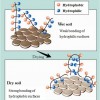 Water-repellent soils are unable to effectively adsorb or retain water. On these soils, water may simply pool on the surface or may move down preferred pathways, leaving large amounts of soil dry even when a large volume of water is applied. Thus, managing water and nutrients in sandy soils is often challenging. This 6-page fact sheet provides an overview of surfactants and how they may be used to better manage water and nutrients in sandy soils for vegetable and fruit production. Written by Guodong Liu, Monica Ozores-Hampton, Gene McAvoy, Ben Hogue, and Crystal A. Snodgrass, and published by the UF Department of Horticultural Sciences, October 2013.
Water-repellent soils are unable to effectively adsorb or retain water. On these soils, water may simply pool on the surface or may move down preferred pathways, leaving large amounts of soil dry even when a large volume of water is applied. Thus, managing water and nutrients in sandy soils is often challenging. This 6-page fact sheet provides an overview of surfactants and how they may be used to better manage water and nutrients in sandy soils for vegetable and fruit production. Written by Guodong Liu, Monica Ozores-Hampton, Gene McAvoy, Ben Hogue, and Crystal A. Snodgrass, and published by the UF Department of Horticultural Sciences, October 2013.
http://edis.ifas.ufl.edu/hs1230
Poultry Manure as a Fertilizer
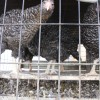 Animal manures have been used as natural crop fertilizers for centuries. Because of poultry manure’s high nitrogen content, it has long been recognized as one of the most desirable manures. Besides fertilizing crops, manures also supply other essential plant nutrients and serve as a soil amendment by adding organic matter, which helps improve the soil’s moisture and nutrient retention. Organic matter persistence will vary with temperature, drainage, rainfall, and other environmental factors. This 2-page fact sheet was written by Michael A. Davis, D.R. Sloan, Gerald Kidder, and R.D. Jacobs, and published by the UF Department of Animal Science, November 2013.
Animal manures have been used as natural crop fertilizers for centuries. Because of poultry manure’s high nitrogen content, it has long been recognized as one of the most desirable manures. Besides fertilizing crops, manures also supply other essential plant nutrients and serve as a soil amendment by adding organic matter, which helps improve the soil’s moisture and nutrient retention. Organic matter persistence will vary with temperature, drainage, rainfall, and other environmental factors. This 2-page fact sheet was written by Michael A. Davis, D.R. Sloan, Gerald Kidder, and R.D. Jacobs, and published by the UF Department of Animal Science, November 2013.
http://edis.ifas.ufl.edu/aa205
What is urea-triazone nitrogen?
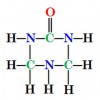 Foliar application of nitrogen and other nutrients essential for plant growth and development is an important practice for crop production. Most foliar nutrient N products contained the traditional N sources such as ammonium, nitrate and/or urea before urea-triazone N was available on the market. The traditional N sources have a greater salt index and leaf-burn potential than urea-triazone N. To avoid or minimize leaf burning, urea-triazone N fertilizers can be used instead of the traditional N sources. But growers have concerns about the safety of using triazone N fertilizers for commercial crop production because the fertilizers are still new to them. This 2-page fact sheet provides basic information on urea-triazone-based fertilizer for county faculty, crop consultants and advisors, growers, and students interested in commercial crop production. Written by Guodong Liu and Jeffrey Williamson, and published by the UF Department of Horticultural Sciences, October 2013.
Foliar application of nitrogen and other nutrients essential for plant growth and development is an important practice for crop production. Most foliar nutrient N products contained the traditional N sources such as ammonium, nitrate and/or urea before urea-triazone N was available on the market. The traditional N sources have a greater salt index and leaf-burn potential than urea-triazone N. To avoid or minimize leaf burning, urea-triazone N fertilizers can be used instead of the traditional N sources. But growers have concerns about the safety of using triazone N fertilizers for commercial crop production because the fertilizers are still new to them. This 2-page fact sheet provides basic information on urea-triazone-based fertilizer for county faculty, crop consultants and advisors, growers, and students interested in commercial crop production. Written by Guodong Liu and Jeffrey Williamson, and published by the UF Department of Horticultural Sciences, October 2013.
http://edis.ifas.ufl.edu/hs1233
Protected Culture for Vegetable and Small Fruit Crops: Southern Highbush Blueberry Cultivars under High Tunnels
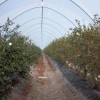 High tunnels have been proposed as an alternative for freeze protection and to increase fruit earliness of southern highbush blueberry. But there is no information about the effect of this type of structure on southern highbush blueberry fruit earliness under subtropical Florida conditions. This 3-page fact sheet summarizes the results of 2-year study in a commercial southern highbush blueberry farm in North Central Florida to compare early fruit weight in high tunnels to that of open fields. This 3-page fact sheet was written by Bielinski M. Santos and Teresa P. Salame-Donoso, and published by the UF Department of Horticultural Sciences, July 2013.
High tunnels have been proposed as an alternative for freeze protection and to increase fruit earliness of southern highbush blueberry. But there is no information about the effect of this type of structure on southern highbush blueberry fruit earliness under subtropical Florida conditions. This 3-page fact sheet summarizes the results of 2-year study in a commercial southern highbush blueberry farm in North Central Florida to compare early fruit weight in high tunnels to that of open fields. This 3-page fact sheet was written by Bielinski M. Santos and Teresa P. Salame-Donoso, and published by the UF Department of Horticultural Sciences, July 2013.
http://edis.ifas.ufl.edu/hs1226
Management Considerations for Wheat Production in Florida
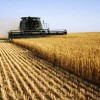 Higher wheat prices created the impetus for growing wheat in the southeastern United States. Since increasing amounts of corn have been diverted to ethanol production, there is a shortage of grain for America’s livestock industry. This shortage results in higher wheat and soybean prices. Wheat and soybean have been grown together as a double crop throughout the Southeast for many years, which generally increases profitability compared with growing only one of the crops. Planting wheat followed by cotton, peanut or grain sorghum has also become a common practice. The best management practices for high yields of wheat in the Southeast Coastal Plain are well established. This 3-page fact sheet lists production practices for small grains in Florida. Written by D.L. Wright, A.R. Blount, R.D. Barnett, C.L. Mackowiak, N. Dufault, and J. Marois, and published by the UF Department of Agronomy, October 2013.
Higher wheat prices created the impetus for growing wheat in the southeastern United States. Since increasing amounts of corn have been diverted to ethanol production, there is a shortage of grain for America’s livestock industry. This shortage results in higher wheat and soybean prices. Wheat and soybean have been grown together as a double crop throughout the Southeast for many years, which generally increases profitability compared with growing only one of the crops. Planting wheat followed by cotton, peanut or grain sorghum has also become a common practice. The best management practices for high yields of wheat in the Southeast Coastal Plain are well established. This 3-page fact sheet lists production practices for small grains in Florida. Written by D.L. Wright, A.R. Blount, R.D. Barnett, C.L. Mackowiak, N. Dufault, and J. Marois, and published by the UF Department of Agronomy, October 2013.
http://edis.ifas.ufl.edu/ag293
Lettuce Cultivars Suitable for Use in Southern Florida
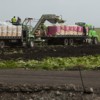 Lettuce is an economically important winter vegetable crop in Florida, with approximately 11,000 acres in production and a farm gate value of $40–$50 million annually. Florida lettuce production occurs mainly in the Everglades Agricultural Area (EAA). In recent years, research scientists at the University of Florida conducted variety trials that included the major cultivars of romaine and iceberg types. These trials were conducted on organic soil in the Everglades Agricultural Area and the IFAS-recommended practice was followed. This 3-page fact sheet describes lettuce cultivars suitable for production on organic soils in the EAA of southern Florida. Written by Huangjun Lu, and published by the UF Department of Horticultural Sciences, October 2013.
Lettuce is an economically important winter vegetable crop in Florida, with approximately 11,000 acres in production and a farm gate value of $40–$50 million annually. Florida lettuce production occurs mainly in the Everglades Agricultural Area (EAA). In recent years, research scientists at the University of Florida conducted variety trials that included the major cultivars of romaine and iceberg types. These trials were conducted on organic soil in the Everglades Agricultural Area and the IFAS-recommended practice was followed. This 3-page fact sheet describes lettuce cultivars suitable for production on organic soils in the EAA of southern Florida. Written by Huangjun Lu, and published by the UF Department of Horticultural Sciences, October 2013.
http://edis.ifas.ufl.edu/hs1225
Conversions of parts per million on soil test reports to pounds per acre
 Soil testing and the resulting fertilization recommendations are critical for appropriate nutrient management in commercial vegetable production, but growers and soil experts sometimes speak different languages. This 8-page fact sheet provides a simple conversion method for crop consultants, crop advisors, growers, students, and researchers who are interested in nutrient and water management of crop production. Written by Guodong Liu, Yuncong Li, and Aparna Gazula, and published by the UF Department of Horticultural Sciences, August 2013.
Soil testing and the resulting fertilization recommendations are critical for appropriate nutrient management in commercial vegetable production, but growers and soil experts sometimes speak different languages. This 8-page fact sheet provides a simple conversion method for crop consultants, crop advisors, growers, students, and researchers who are interested in nutrient and water management of crop production. Written by Guodong Liu, Yuncong Li, and Aparna Gazula, and published by the UF Department of Horticultural Sciences, August 2013.
http://edis.ifas.ufl.edu/hs1229
Cabbage aphid Brevicoryne brassicae Linnaeus (Insecta: Hemiptera: Aphididae)
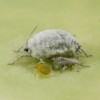 Cabbage aphids cause significant yield losses to many crops of the family Brassicaceae, which includes the mustards and crucifers. It is important to have a comprehensive understanding of this pest and its associated control measures so that its spread and damage can be prevented. This 5-page fact sheet was written by Harsimran Kaur Gill, Harsh Garg, and Jennifer L. Gillett-Kaufman, and published by the UF Department of Entomology and Nematology, October 2013.
Cabbage aphids cause significant yield losses to many crops of the family Brassicaceae, which includes the mustards and crucifers. It is important to have a comprehensive understanding of this pest and its associated control measures so that its spread and damage can be prevented. This 5-page fact sheet was written by Harsimran Kaur Gill, Harsh Garg, and Jennifer L. Gillett-Kaufman, and published by the UF Department of Entomology and Nematology, October 2013.
http://edis.ifas.ufl.edu/in1014
University of Florida Potato Variety Spot Light: Red LaSoda
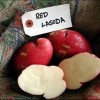 Red LaSoda is the red-skinned fresh-market potato standard for Florida. It was observed in 1949 as a deep red mutant of LaSoda in the Louisiana potato breeding program. It has been in trials over many seasons and at many locations in Florida including university and grower sites. Production and quality results provided in this 4-page fact sheet are summarized from the red-skinned fresh-market trials conducted by the University of Florida over the past 14 seasons. Written by Lincoln Zotarelli, Doug Gergela, Chad M. Hutchinson, David Dinkins, and Edsel Redden, and published by the UF Department of Horticultural Sciences, August 2013.
Red LaSoda is the red-skinned fresh-market potato standard for Florida. It was observed in 1949 as a deep red mutant of LaSoda in the Louisiana potato breeding program. It has been in trials over many seasons and at many locations in Florida including university and grower sites. Production and quality results provided in this 4-page fact sheet are summarized from the red-skinned fresh-market trials conducted by the University of Florida over the past 14 seasons. Written by Lincoln Zotarelli, Doug Gergela, Chad M. Hutchinson, David Dinkins, and Edsel Redden, and published by the UF Department of Horticultural Sciences, August 2013.
http://edis.ifas.ufl.edu/hs323
Integrated Pest Management in Protected Structures I: Basic Principles and Scouting
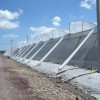 The fundamentals of managing pests in protected structures are very similar in many respects to managing pests in field crops. But conditions within a protected structure can be modified to a certain degree to prevent, delay, or even mitigate pest issues. On the other hand, conditions that discourage one group of pests can often favor another. This 7-page fact sheet was written by Hugh A. Smith, Gary E. Vallad, and Bielinski M. Santos, and published by the UF Department of Entomology and Nematology, June 2013.
The fundamentals of managing pests in protected structures are very similar in many respects to managing pests in field crops. But conditions within a protected structure can be modified to a certain degree to prevent, delay, or even mitigate pest issues. On the other hand, conditions that discourage one group of pests can often favor another. This 7-page fact sheet was written by Hugh A. Smith, Gary E. Vallad, and Bielinski M. Santos, and published by the UF Department of Entomology and Nematology, June 2013.
http://edis.ifas.ufl.edu/in994
2013 Cotton Defoliation and Harvest Aid Guide
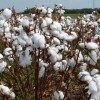 In Florida, cotton requires about 155 days of growth from planting to harvest. Throughout the growing season, growers must make important management decisions about defoliation, boll opening, and regrowth suppression. These factors can affect the quality and storage time if the crop is put into modules. The greatest losses in quality are caused by stain from poorly defoliated plants or regrowth and moisture from green tissue. This 8-page fact sheet was written by R.G. Leon, D. L. Wright and B. J. Brecke, and published by the UF Department of Agronomy, October 2013.
In Florida, cotton requires about 155 days of growth from planting to harvest. Throughout the growing season, growers must make important management decisions about defoliation, boll opening, and regrowth suppression. These factors can affect the quality and storage time if the crop is put into modules. The greatest losses in quality are caused by stain from poorly defoliated plants or regrowth and moisture from green tissue. This 8-page fact sheet was written by R.G. Leon, D. L. Wright and B. J. Brecke, and published by the UF Department of Agronomy, October 2013.
http://edis.ifas.ufl.edu/ag188